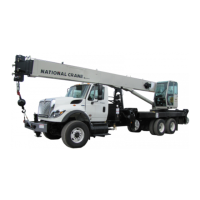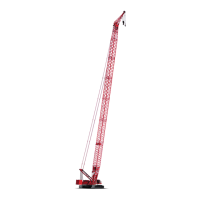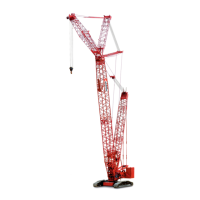INTRODUCTION 14000 SERVICE MANUAL
1-56
Published 09-05-14, Control # 226-02
When mast cylinders are extending, node 4 controller
monitors drum 4 speed sensor. Node 1 controller maintains a
speed that is proportional to accessory system hydraulic
pressure applied to mast raising cylinders. Mast assist arms
will stop rising when mast cylinders are fully extended.
Node 3 controller monitors mast angle sensor when mast is
moving. Diagnostic screen monitors mast operating angle.
When mast is raised to operating range, move boom hoist
handle to center position.
Node 4 controller sends a zero volt output signal to drum 1
pump EDC to de-stroke the pump. Node 3 controller sends a
zero output voltage to shift spool of mast cylinders raise
solenoid valve HS-22 to center position.
Mast Lowering
The following drum raising operation is for drum 4 while
lowering mast from setup working position to gantry. Node 3
controller monitors the mast angle sensor.
Use Rated Capacity Indicator/Limiter, Diagnostic screen to
select the Liftcrane Mast Handling Capacity Chart. Mast
controls will not operate and the mast operating limits remain
off until Liftcrane Mast Handling Capacities Chart is selected.
Use mast switch on overhead console in cab to raise mast
assist arms until cylinders stall and stop.
Move drum 4 (boom hoist) control handle back for automatic
mast-lowering procedure. Node 4 controller sends a variable
24 volt output signal to drum 1 pump EDC to stroke pump in
low-pressure direction. Node 3 controller sends a 24 volt
output to enable mast cylinders lower solenoid valve HS-23
in retract (mast lower) direction. Solenoid valve shifts to
block tank port and open port to low-pressure side of drum 1
pump.
As mast lowers toward transport position, drum 4 hauls in
wire rope between mast drum and gantry sheaves.
From accessory valve, fluid pressure enters free-flow check
valve sections on side B of load equalizing valve. From
equalizing valve, fluid enters counterbalance valves and rod
end of mast cylinders, retracting cylinder rods.
Fluid flow from piston end of mast cylinders is blocked by
free-flow check valve sections on side A of counterbalance
valves and flows through valve flow restrain sections preset
for a relief pressure of 3,480 psi (240 bar). Counterbalance
valves operate with a 5:1 pilot ratio of the relief valve
pressure, permitting valve to open when pressure in piston
end of cylinders is approximately 700 psi (48 bar).
Hydraulic fluid from side A sections of both counterbalance
valves combines, and free-flow check valve section on side
A of load equalizing valve blocks the flow. The fluid then
passes through the valve flow restrain section that is preset
at 4,000 psi (276 bar). Load equalizing valve operates with a
1.5:1 pilot ratio of the relief valve pressure, permitting valve
to open when the hydraulic pressure on side A of the load-
equalizing valve is approximately 2,680 (185 bar).
Restraining section on side B of load equalizing valve opens,
controlling flow of fluid out of cylinders to ensuring cylinder
operation is balanced.
When mast cylinders are retracting, node 3 controller
monitors drum 4 speed sensor and mast angle sensor when
mast is moving. Node 1 controller maintains a speed that is
proportional to accessory system hydraulic pressure applied
to mast cylinders.
When mast reaches approximately 35°, move boom hoist
handle to center position. Retract back hitch pins and lower
gantry with gantry cylinders switch on remote control. When
gantry is in shipping position, use mast switch on overhead
console in cab to lower mast assist arms fully.
When mast switch is released, node 3 controller sends a
zero output voltage to drum 1 pump EDC that moves
swashplate to center position. Node 4 controller sends a
zero output voltage to shift spool of mast cylinders lower
solenoid valve HS-23 to center position.

